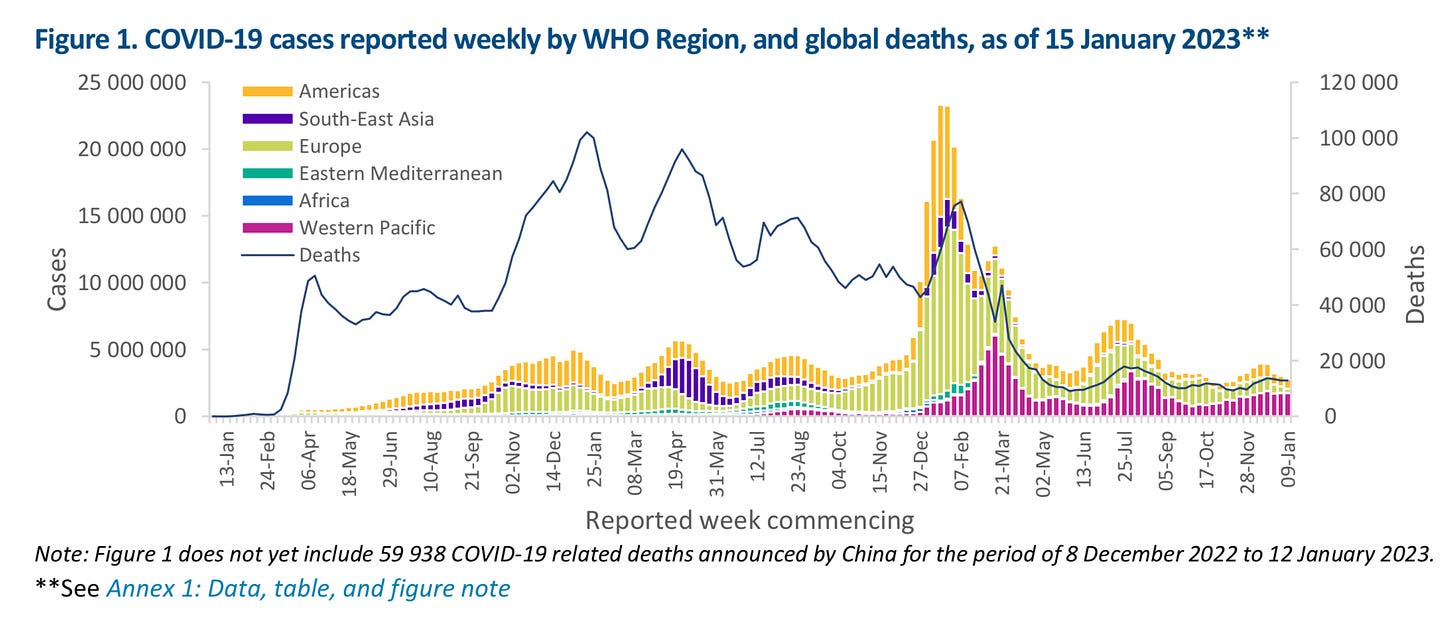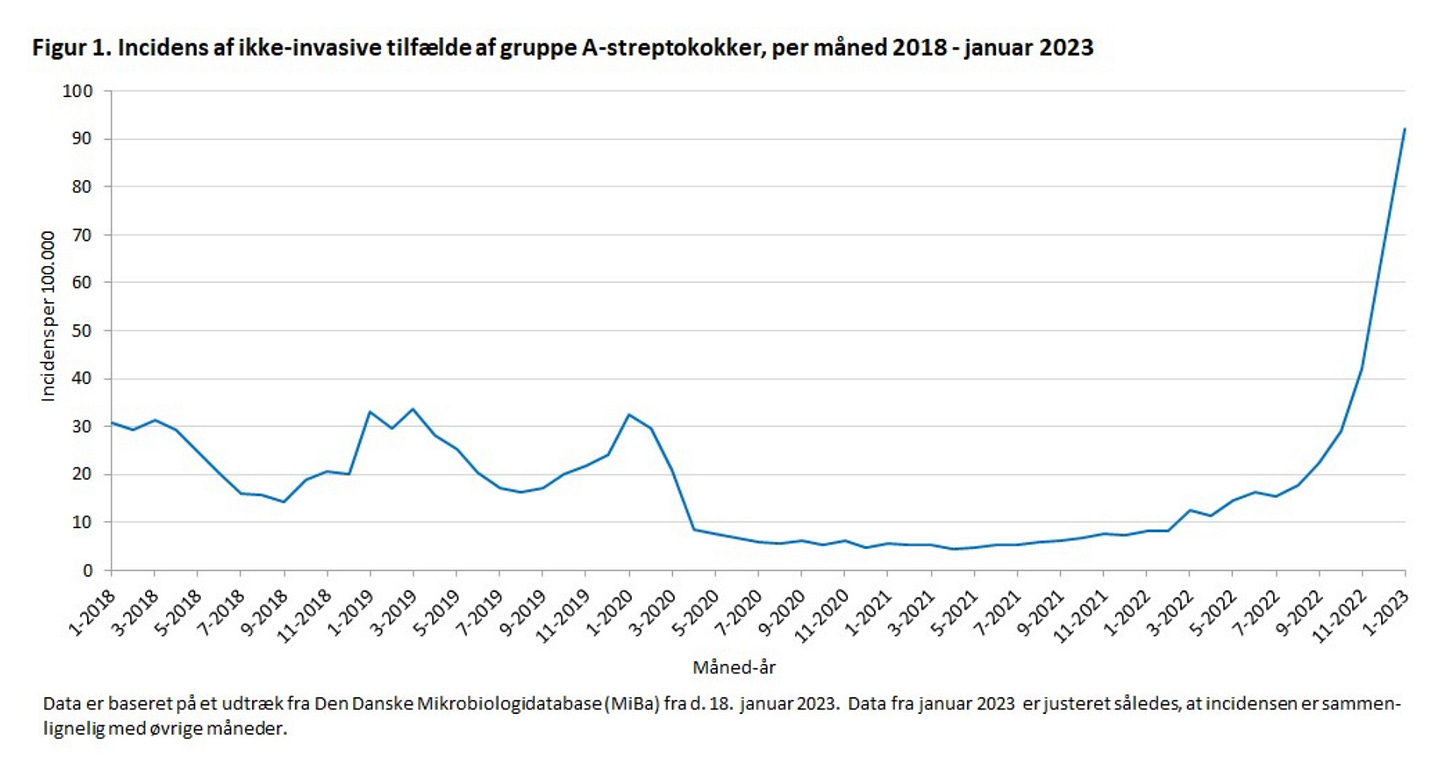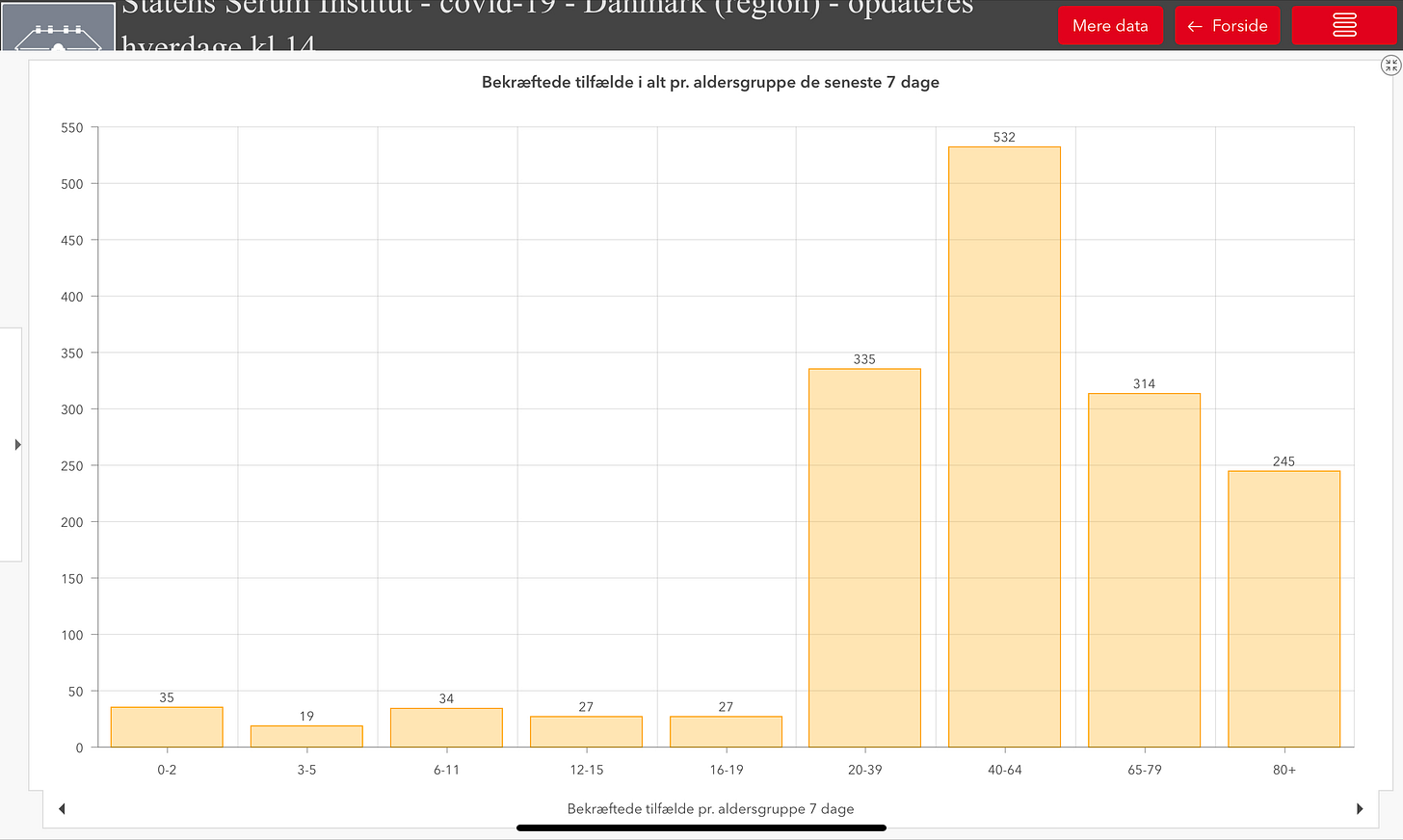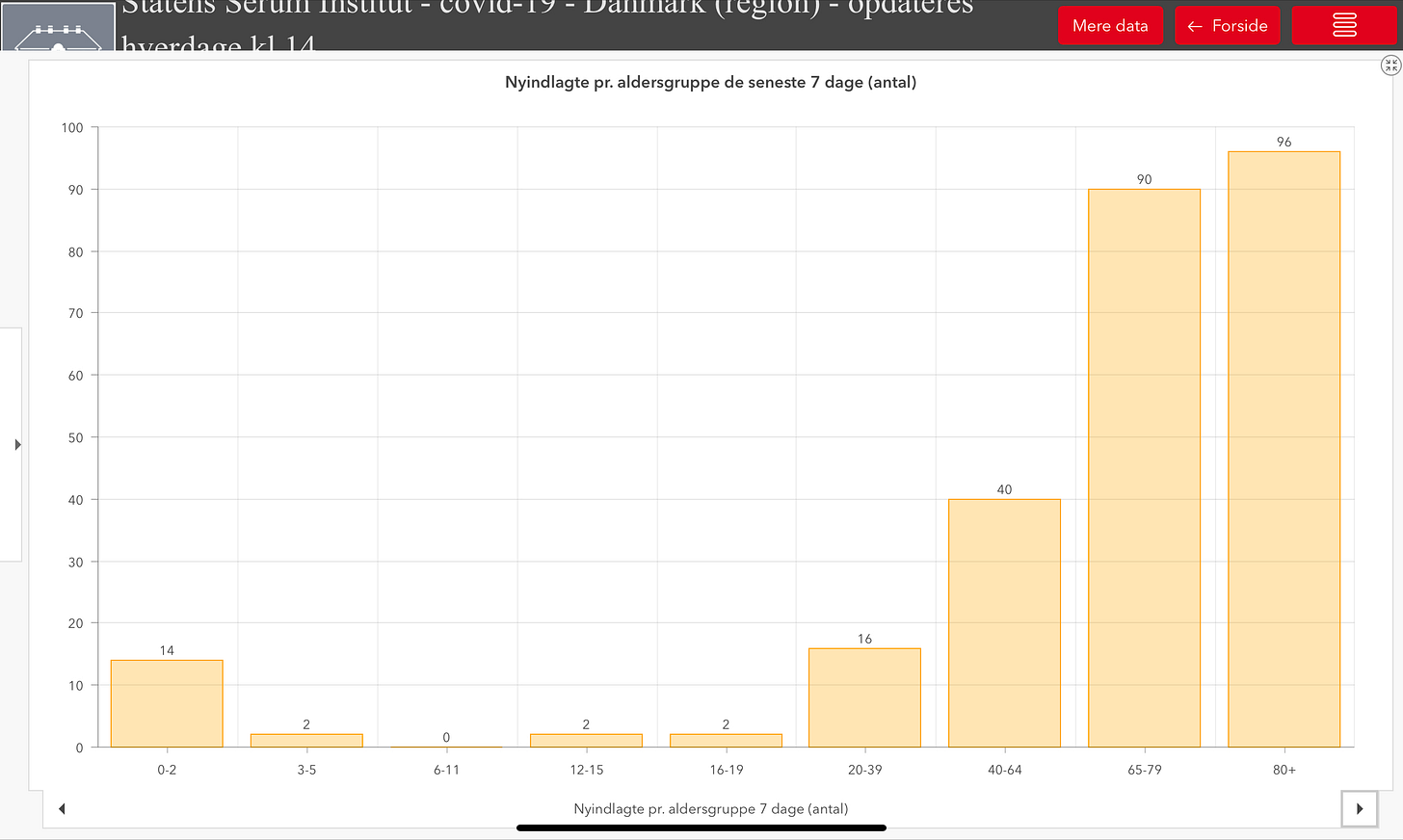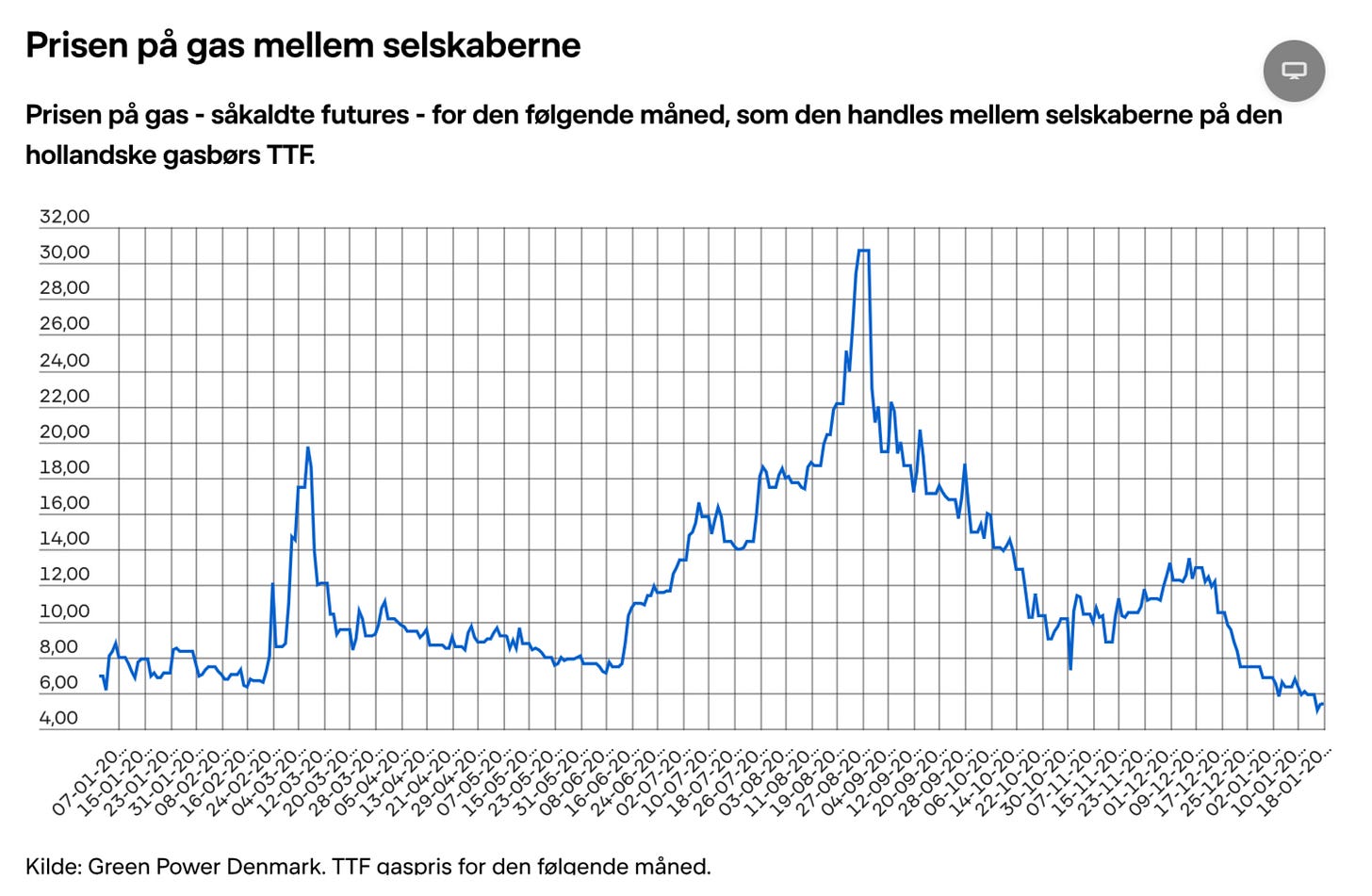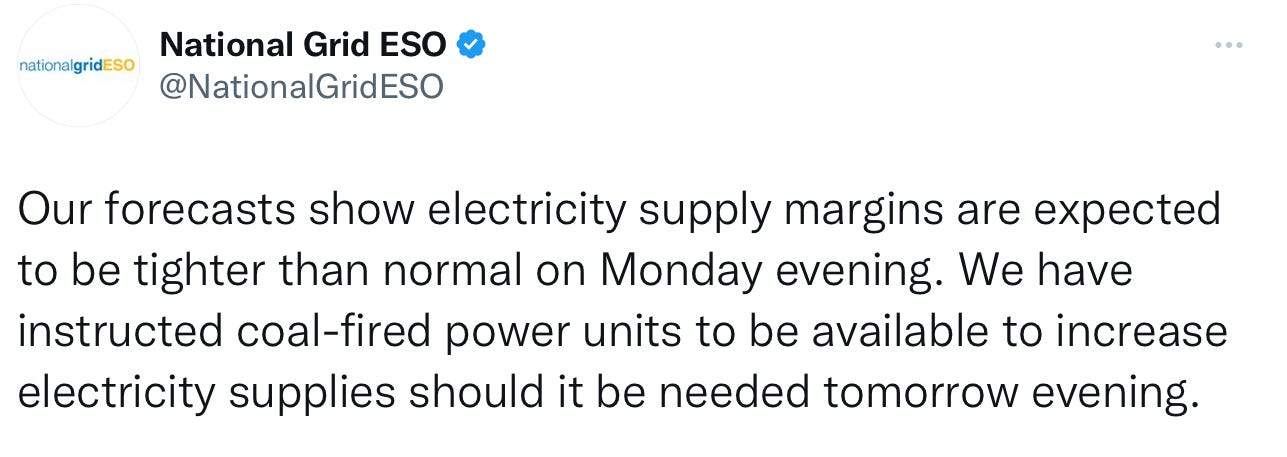Monday Morning News & Notes
COVID deaths rise globally. Another pandemic ripple effect arrives in Denmark.
🦠Pandemic🦠
🌏🦠
COVID deaths have increased around the globe, according to the latest pandemic snapshot from the World Health Organization. In the week ending January 15, there were 2.9 million new infections while another 13,000 lives were lost, an 18% increase week to week. Looking at the previous 28 days, there were nearly 13 million infections and 53,000 coronavirus deaths, a 20% increase from the previous 28-day period.
The WHO notes the pandemic deaths in this report do not include the nearly 60,000 coronavirus fatalities reported by China.
“Weekly and monthly trends need to be interpreted carefully considering the reduction in testing and delays in reporting in many countries during the year-end holiday season.”
By region, pandemic deaths increased in the Western Pacific (+43%), the Americas (+10%), and the Eastern Mediterranean (+9%). In Africa fatalities were unchanged week to week, while numbers dropped in Europe (-40%) and South-East Asia (-13%).
At the country level, weekly coronavirus deaths have surged in the United States with another 3,922 American lives lost (+46%), followed by Japan with 2,849 fatalities (+33%), and Australia where 742 deaths were recorded after seeing no pandemic deaths in the previous three weeks.
The WHO says the BA.5 variant and its host of sub-variants remain dominant around the planet based on a vastly reduced number of testing and the sequencing of positive test results. The global health agency continues to keep a very close eye on four sub-variants BF.7, BQ.1, BA.2.75, and XBB recombinant strains, all of which have a greater ability to punch through immune protections.
🇪🇺🦠
COVID numbers are dropping across the board in the European Union and the greater European Economic Area. That is according to the latest weekly pandemic assessment from the European Centre for Disease Prevention and Control. Overall, infection numbers, hospitalizations, and fatalities have all declined. However, the ECDC cautions to take the much improved pandemic picture with a grain of salt, as there may still be some holiday hangover in testing and reporting that might be skewing the numbers.
Taking a more macro look at the country level, out of 27 countries reporting infection numbers, four saw increasing infection activity in the second week of the year. Three of the 24 countries reporting hospital admissions data saw either general admissions or ICU numbers rise. Two countries are reporting increasing fatalities. In Greece, it is seeing rising infection numbers among seniors, increasing ICU admissions, and deaths.
The ECDC says in contrast to the improving pandemic picture in Europe, virus deaths “continue to have a considerable impact.” In the second week of the month, the coronavirus claimed 1,624 lives in Europe. Of those, seniors continue to bear the brunt of COVID deaths. In the last four weeks, 27% of pandemic deaths have been among those 65 to 79 years old, and 67% have been seniors over the age of 80.
“This highlights the importance of COVID vaccine booster doses, particularly among groups vulnerable to severe infections.”
Across Europe, just 34.4% of those 60 years old and older have a 2nd booster dose.
Over the next two weeks, the ECDC is forecasting that infection numbers and deaths will decline in Europe, while hospitalizations will remain stable.
Just ten countries are testing and sequencing in numbers large enough to get reliable data from. Of those, 49% of cases in the first week of January came back as BQ.1 infections. 24.5% were the BA.5 variant, 12.7% were BA.2.75, and 1.4% were confirmed XBB.1.5 infections.
🇩🇰
An infection trend that has been sweeping across Europe has now arrived in Denmark. Since things returned to ‘near-normal’ after COVID restrictions were lifted, some European countries have begun to report sharply increasing numbers of streptococcal infections. These would be things like strep throat, scarlet fever, and children’s ulcers, other wise known as GAS infections. More severe streptococcal infections also began to increase, or so-called iGAS infections; these would be serious issues like meningitis, blood poisoning, or in some cases toxic shock syndrome.
The Statens Serum Institute says the number of GAS infections “has now reached a level that far exceeds normal for this time of year.” And, it says iGAS cases have tripled in a month, jumping from 22 infections in November to 68 in December.
Department Head Dr. Peter Henrik Andersen:
“It is SSI's expectation that the number of positive cases may continue to rise for some time to come. Usually there are the most invasive cases in the months of January to March, but there are also signs of many positive tests in January so far.”
The SSI says seniors, especially those with underlying health conditions or compromised immune systems, are most at risk. But, children under five can also fall victim to both streptococcal infections.
The institute says there has been an “increasing number” of deaths within 30 days of an iGAS infection, but “it is not proportionately more than usual.” It notes that elsewhere in Europe there have been deaths among children due to iGAS infections but it hasn’t confirmed any fatalities among children in Denmark.
“The fact that we in Denmark, and all over Europe, are seeing such a sharp increase [of streptococcal infections] right now may possibly be due to the bacterium making a comeback after being suppressed due to COVID restrictions. Infections with this type of bacteria have been at a lower level during the first long part of the corona pandemic. It seems that the increase that we have also seen for some other infections after society was opened up again is now also happening for group A streptococci.”
An SSI risk assessment concludes that the risk of further spread among children in “very high” but for serious outcomes it is “very low.” Overall, the risk to children is deemed low. Seniors are once again more in harms way, with the institute deeming their risk to be moderate for both infection risk and for the likelihood of a serious outcome.
Department Head for Bacteria, Parasites, and Fungi Steen Hofmann:
“It is important that doctors pay attention. It is the invasive infections among the older parts of the population that we are most worried about.”
The SSI says it is following developments, both within Denmark and internationally, very closely.
-
Over the last seven days, infection trends have remained more or less the same, but overall numbers have plummeted.
While confirmed infections continue to remain highest among the 20 to 79 year-old age groups, and especially among those 40 to 64 years old, the actual number of infected people has fallen by half, or nearly half, in each of three different age groups.
-
As for COVID hospitalizations over the last week, it is a similar story. While seniors 65 years old and older continue to suffer the most infection-related hospitalizations, the actual numbers have fallen by nearly half week to week. In the last seven days, 71% of all coronavirus hospital admissions have been seniors.
-
COVID lockdowns did not result in an increase in a number of mental health challenges for young people like eating disorders, suicidal thoughts, and attempted suicides. That is the conclusion of a new Danish study. But not everyone is onboard with the study’s findings.
The study was conducted by the Department of Public Health Sciences, the University of Copenhagen, and the Danish Research Institute for Suicide Prevention. It relies heavily on surveys sent out to tens of thousands of young people before, during, and after the two major COVID lockdowns. The survey answers were compared to each other and to a huge amount of data collected by the Statens Serum Institute between 1997 and 2004. It basically found that while some young people did suffer due to lockdowns, others had much less stress due to not being in school. The result is essentially a stalemate.
Researcher, and PhD student, Stine Danielsen:
“We thought that social restrictions for young people would have a really big impact on their mental health. When we look at it overall, it actually hasn't changed. Some groups have gotten worse during the lockdown, while others have had a beneficial effect from it, and therefore we end up with the overall conclusion that there has been no change.”
The National Association for Mental Health says for those struggling with different disorders and mental health issues before the pandemic, lockdowns made things much worse.
Chairwoman Mia Kristina Hansen said to DR it was that group that was underrepresented in the surveys that served as the study’s foundation.
“Some of the young people, who were already struggling when the coronavirus came, got worse because suddenly there were no longer any communities they could be a part of. They were perhaps isolated beforehand, and then they just became even more so when everything shut down. If you are very severely challenged, it may well be that you are less inclined to participate in these studies. Therefore, we also do not want to say that this 100% applies to the population as a whole.”
The Chair of the Danish Psychological Association, Eva Secher Mathiasen, points out that the pandemic may have given rise to other mental problems than the ones examined in the new study.
“The incidence of anxiety and depression is quite high, and there has clearly been an increase in the aftermath of the pandemic.”
Another major flaw is that the survey only included young people over the age of 18 and not any younger age groups according to Senior Physician Mia Gall Grandahl who says the study simply does not correspond to reality.
“There is a big risk that those who are having a hard time will not answer the questionnaire and thus quit the study. It is my opinion that there is a preponderance of children and young people who have had it worse. The results of this study do not agree with what I experience, what I hear from clinicians, and the other studies I have seen.”
She says that in her professional experience there is a higher proportion of young people suffering from eating disorders, self-harm, suicidal thoughts, and suicide attempts.
🇸🇪
The coronavirus, influenza, and RS virus waves may have all peaked in Sweden. That is according to the latest update from the Swedish Public Health Agency. It says in all three cases, infection numbers are in decline.
On the COVID front, it says there has been a 35% decrease in confirmed cases, an extremely unreliable statistic due to Sweden’s lackluster testing program. However, it also reports an “almost as great” drop among vulnerable seniors in care, a high-risk population where there is some level of regular PCR testing. The health agency says coronavirus activity is now somewhere in the neighbourhood of what was happening in Sweden in November, before the latest infection wave rook off.
COVID hospitalizations have “decreased slightly” in Sweden while ICU numbers are treading water, but Folkhälsomyndigheten doesn’t provide any specific numbers.
Addressing the extremely high number of pandemic deaths in recent weeks, the agency says the increase “has stopped somewhat” but as of yet there is no reduction in fatalities.
State Epidemiologist Anders Lindblom:
“The infection spread is basically decreasing throughout the country, which indicates that the peak has been passed for these latest waves. But there is a risk that the infection spread will pick up speed again. We will only see the effect of people meeting more again after returning to school and work after the holidays over the next few weeks.”
Sweden has also seen its first 20 cases of the XBB.1.5 variant, while the BA.2 and BA.5 strains and their sub-variants are dominant at the moment.
The health agency says influenza cases have also dropped by 40% week over week. The reduction in infection numbers is seen across the country and all age groups. Flu-related intensive care numbers also declined; again no numbers were provided.
RS virus cases are down by 20%. It says the infection wave specifically among children under the age of five, peaked in the third week of December and case numbers have “more than halved” since then.
All that said, the Swedish Public Health Agency says respiratory viruses continue to spread across the county and it urges people to get their flu shot and make sure they are vaccinated and boosted against COVID.
🇫🇮
The development of a COVID nasal vaccine by Finland’s Rokote Laboratories is still ongoing, but there are steep challenges in getting it to market. First phase clinical trials, which were supposed to begin last year, are now due to begin at the end of this year. The nasal vaccine, called FINCoVac, has shown promising results in animal trials.
Director of Research and Product Development Erkko Ylösmäki says if eventually approved for use in the EU the nasal vaccine could play an important role.
“The advantage of a vaccine given to the mucous membrane is that it would be able to more effectively prevent the virus from entering the body already in the nasopharynx, so that infection does not occur. When a person doesn't get infected, he doesn't spread the disease either.”
Part of the reason for the delays has been work on updating the vaccine for different emerging variants. But, with clinical trials yet to start and many hurdles still looming to get it approved by the European Medicines Agency, the vaccine is at best still years away. The company says if absolutely everything goes to plan, it might hit the market in 2025, at the earliest.
Currently, there are no COVID nasal vaccines approved for use in Europe.
🇩🇪
Excess mortality rates in Germany are soaring, and while the pandemic is certainly playing a large role, it turns out the situation may be a little more complicated than that.
In the first two years of the pandemic, Germany suffered about 180,000 more deaths than would be expected according to Federal Statistical Office. Most striking is that excess deaths have continued to rise even after COVID vaccines arrived. And, no experts have already ruled out any link between vaccines and increasing deaths, despite baseless conspiracy theories claiming otherwise.
In the first year of the pandemic, there were around 39,000 more deaths than the average of previous years. That rose to 68,000 excess deaths in 2021 and then to 74,000 more deaths in 2022. Seniors suffered the most, especially those over the age of 80.
Germany’s Robert Koch Institute says with the pandemic death toll exceeding 164,000 lives lost, the coronavirus is obviously a major factor.
German Association of General Practitioners Chair Markus Beier said the return of the usual viruses, like influenza, has also been a contributing factor to excess deaths.
“One reason for this was the necessary COVID restrictions, which of course also prevented the transmission of other pathogens.”
Last summers heat wave also claimed 4,500 additional lives in Germany.
Federal Institute for Population Research Director Sebastian Klüsener:
“At the moment we can only make assumptions. During heat waves, for example, many people die with previous illnesses who would have died a little later anyway.”
Klüsener also points to influenza returning with a vengeance.
“This is substantiated by figures from the RKI. However, it will only be possible to say how great the effects of the individual events actually were when the Federal Statistical Office’s cause of death statistics are available for 2022.”
He says there may also be other indirect factors from the pandemic contributing to excess deaths
“For example, cancer because there were no preventive medical check-ups because of Corona.”
German Health Minister Karl Lauterbach:
“The high excess mortality in 2022 gives reason for changes. We must better protect older people from heat death in summer. In winter, the flu vaccination and corona vaccination campaigns need to work better.”
-
The German state of Bavaria is ending a requirement that people who work in medical practices and facilities no longer have to wear a mask. The mandate will end February 1.
In Germany, COVID restrictions can be levied by the national government and the government of its 16 different states. While Bavaria ends its mask mandates, federal rules require that FFP2 masks be worn in clinics and care facilities by both employees as well as patients and visitors.
German Health Minister Karl Lauterbach is not a fan of Bavaria’s decision to end its mask mandates.
“In Bavaria it can now happen that an infected asymptomatic doctor infects many old or chronically ill patients. Because he's not wearing a mask. The number of cases is currently too high for this risk.”
-
German Health Minister Karl Lauterbach wants to launch major initiatives backed by significant funding to help those suffering from long-COVID. Lauterbach told the Rheinische Post that a long-COVID hotline will soon be set up in his ministry. It would serve as a contact point for long-COVID information and help point people to treatment.
“We must not leave people with long-COVID hanging. For them, the pandemic is far from over. In the ministry, we want to set up a hotline, information exchange, and focus on health services research.
The minister says he also wants to earmark €100 million for long-COVID research to better treat those suffering from coronavirus symptoms long after recovering from the initial infection.
“We assume that a relevant proportion of those who fall ill after a corona infection are struggling with long-COVID symptoms. Estimates go from five to ten percent. This often means a struggle for the individual and can even become relevant for the job market if the number of sick people continues to rise.”
🇨🇳
The coronavirus is tearing through the Chinese population like wildfire. Top Chinese epidemiologist Wu Zunyou says eight out of every ten people in China, a country with over 1.4 billion people, have had a COVID infection. The news comes as significant concerns swirl over the infection spread that might be associated with Chinese New Year celebrations.
Wu Zunyou appears to be banking on herd immunity, at a time when more variants are much more immune invasive, as he said the in two or three months the risk of more major outbreaks “is very small.”
After revealing there have been almost 60,000 pandemic deaths in China in just one month, Chinese authorities are adding another 13,000 lives lost just last week. Again, keep in mind, pandemic numbers from China are highly dubious and are very likely to be understated.
🇨🇦
It is too early to relax COVID measures in Canada. That was the message in a rare pandemic update on Friday afternoon from Chief Public Health Officer Dr. Theresa Tam. She says the spread of the much more contagious XBB.1.5 variant and the Canadian healthcare system still trying to pick up the pieces mean that is is still important to do everything possible to prevent severe infections.
“We are seeing an increase in the proportion of sequence detections associated with the XBB.1.5 variant.”
She says during the last week of December about 2.5% of infections came back as the new XBB.1.5 variant.
“This proportion is projected to rise at approximately seven per cent by mid-January. While XBB variants are expected to increase in Canada, it is not known whether they will become the dominant lineage.”
In Canada, as is the case elsewhere, there has yet to be any evidence that the new variant causes more severe infections. Although, that has yet to be ruled out definitively, either.
“Like winter weather, it can be difficult to predict exactly what we're going to see next, but we do know it's too early to put away our winter coats and boots. Similarly, it's still too early to start taking [away] the personal protective measures that have helped us weather the COVID storm.”
Tam is urging people to get vaccinated and if they are vaccinated, to make sure those eligible have a booster dose using a bivalent vaccine dose.
Earlier this month, Canada introduced travel restrictions for travelers arriving from China. In order to enter the country they must have a recent negative COVID test. Pilot projects have also been launched in airports in Toronto and Vancouver to include COVID wastewater surveillance on all flights arriving from China and Hong Kong.
⚡️Energy Crisis⚡️
🇩🇰
For homeowners in Denmark broadsided by soaring natural gas prices, the worst may be over. That is the assessment of Danske Bank.
Chief Analyst Jens Nærvig Pedersen said to DR astronomically high gas prices won’t be making a return at least not for many months.
“As the owner of a natural gas boiler, you have to look at how the prices are now, and we will probably see bumps in the road, but we will stay close to this price level for the rest of the heating season.”
An unseasonably warm winter that shattered heat records across Europe was a major factor in reducing energy demand and bringing prices back to earth. It also helped that people in Denmark responding to energy crisis concerns reduced their energy usage so far this winter by 37%.
Currently, Denmark’s gas storages are 89.9% full, according to numbers from Gas Infrastructure Europe.
One of Denmark’s biggest energy companies, Andel Energi, is in agreement and also believes skyrocketing gas prices are gone, at least for this winter.
Manager Jack Kristensen:
“We are in a really reasonable supply situation on the gas markets. There is plenty of gas, and there is also gas in stock.”
Another factor is that in the future we won’t be blindsided by Russia weaponizing its energy exports, and while we aren’t out of the woods yet, Europe is transitioning away from Russian oil and gas at light speed. And even as we appear to have dodged an energy crisis bullet this winter, the European Union is already turning its attention to preparing for the next one.
🇬🇧
But, while the EU takes a big breath of relief, the energy crisis remains a big concern in the United Kingdom. The UK national grid announced on Sunday that it is preparing its emergency coal-fired units in case they are needed today, when power demand increases.
“We are also activating a Live Demand Flexibility Service event between 5-6pm tomorrow. This does not mean electricity supplies are at risk and people should not be worried.”
🇺🇦/ 🇷🇺 War
🇫🇮 🇸🇪/ 🇺🇦
Finland is sending another weapons package to Ukraine and it says it is the biggest one yet. The Finnish Ministry of Defense usually won’t reveal any specific contents of its weapons shipments to Ukraine. But, this time acting Defense Minister Mikko Savola is letting a tiny bit of information slip.
“Ukraine still needs support in its defensive battle. The set of defense equipment to be sent now is clearly the largest we have decided so far. Finland is delivering heavy weapons and ammunition to Ukraine.”
What ever Finland is sending it is significant because it has turned to Sweden for some help facilitating the transaction. The Ministry of Defense says part of the weapons package will be material Finland can only hand to Ukraine because Sweden has stepped in to express “its readiness to support Finland as needed.” The two countries have signed a letter of intent on the matter.
“The defense administrations have worked out how to support Ukraine with the defense material it needs in such a way that the material support would not endanger the implementation of Finland's or Sweden's national defense. Joint support for Ukraine is an indication of the deep mutual trust between Finland and Sweden and the ever-closer defense cooperation.”
This is the 12th weapons package Finland has donated to Ukraine.
🇬🇧/ 🇺🇦
The United Kingdom is also unveiling another weapons package for Ukraine. This one includes 600 Brimstone 1 missiles. The UK announced late last week it is also sending 14 Challenger 2 tanks to Ukrainian forces as heavy armour donations from other countries also begin.
🇳🇱/ 🇺🇦
The Dutch government says it is willing to help foot the bill to get Leopard 2 tanks to Ukraine, but German dithering continues to gum up efforts to transfer the armour. The German made tanks require a re-export permit from Germany to move them from one country to another.
The Netherlands will also send Ukraine two Patriot air defense batteries and is also putting the idea on the table of supplying Ukraine with F-16 fighter jets. Infantry fighting vehicles could also be donated to the Ukraine war effort.
🇪🇺🇺🇸/ 🇺🇦
Last week’s Ukraine summit hosted by the United States, at the Ramstein military base in Germany, did not manage to breakthrough German resistance to sending Leopard 2 tanks to Ukraine. Although some cracks seem to have appeared. European countries with Leopard tanks to give who are waiting on Germany to get onboard have agreed to begin training Ukrainian forces on how to use the tanks.
German Defense Minister Boris Pistorius chose his words carefully when asked about the situation after leaving the summit.
“There are good reasons for the deliveries, and there are good reasons against them. If you look at the whole war situation, which has been going on for almost a year, you have to weigh all the arguments for and against carefully.”
The tanks, which are produced in Germany, require a re-export permit and the support of the German defense industry to move the tanks from country to country and keep them maintained.
🇩🇪/ 🇫🇷
Call it the dithering summit. German Chancellor Olaf Sholz and French President Emmanuel Macron met in Paris over the weekend. Neither is willing to commit to sending heavy armour to Ukraine. Macron has ruled out donating French Leclerc tanks and Sholz is waffling in donating Leopard tanks.
🇩🇰/ 🇺🇦
Denmark is among the countries lobbying Germany to stop its dithering and get the Leopard tanks to Ukraine.
Danish Defense Minister Jakob Ellemann-Jensen spoke to DR:
“I hope that something will happen about the tanks. Denmark is part of a group of countries, led by Estonia, who want to change gears and deliver heavier weapons to Ukraine.”
-
11 tonnes of equipment from Denmark has arrived in Ukraine. The shipment, put together with donations from Danish energy and water industries, will contribute to ensuring people living in the city of Mykolaiv will have clean drinking water and be able to heat their homes on cold winter nights.
Mykolaiv is largely in ruins thanks to relentless Russian attacks aimed at critical civilian infrastructure as part of its terror campaign to try and best Ukraine into submission.
Minister for Climate, Energy, and Utilities Lars Aagaard:
“We must stand together with the Ukrainian civilian population, which has become the target of Putin's brutal attacks. That is why I am grateful that Danish companies and utility companies have, in a short time, donated equipment that can actually contribute to saving lives in Ukraine. It is completely unacceptable that Russia is so determined to target civilian infrastructure in Ukraine. It takes a heavy toll on the population. With our support, we can help provide heat and water for the population so that they can get through the winter.”
The shipment includes things like pumps, valves, and other heating and water parts and machinery.
There are around half-a-million people living in Mykolaiv, which is close to the city of Kherson. The region has been the center of some of the fiercest fighting.
🇳🇴/ 🇺🇦
Norway will provide instructors as part of a multinational effort to provide training on Explosive Ordnance Disposal to the Ukrainian military.
Norwegian Defense Minister Bjørn Arild Gram:
“Training and education of Ukrainian personnel are absolutely central to maintaining Ukraine’s ability to defend itself against Russia’s invasion. Russia makes indiscriminate use of artillery, rockets and missiles in its warfare. Unexploded remnants of these munitions must be disposed of to reduce the threat to both the Ukrainian civilian population and its military. There will be a significant need for mine and explosive ordnance disposal both now and during the reconstruction of the country.”
The training will take place in Lithuania.
🇹🇷/ 🇸🇪 🇫🇮
It is unlikely the Turkish government will hold a ratification vote on Sweden and Finland’s NATO memberships until sometime after May 14. That is when Turkish President Recep Tayyip Erdoğan has called a national election. Erdoğan who holds near dictatorship powers in Turkey is facing challenges from within and without. The Turkish economy is in shambles, inflation in Turkey hit 85% in the fall, he has played footsie with Russia, while also blocking Sweden and Finland from joining NATO, and outraged western Allie’s by buying Russian anti-missile defense systems.
28 out of 30 NATO member nations have ratified Sweden and Finland’s ascension protocols, with just Hungary and Turkey yet to vote.
🇫🇷
Like a lot of other countries across Europe, France is now massively increasing defense spending. It will be boosted by 40% beginning in 2024 shooting to €413 billion, up from €295 billion. By 2030, the defense budget in France will be nearly double what it was in 2017.
Since Russia invaded Ukraine, the security situation in Europe has undergone a sea change, with European nations drastically increasing defense spending almost overnight.
🇺🇸/ 🇷🇺
The United States has sanctioned the Russian private militia group that is fielding thousands of soldiers in Ukraine. The U.S. has designated the Wagner Group a “transnational criminal organization.” This empowers the States to begin to take action against companies, associates, and networks that supply the mercenary organization with money, weapons, and other goods and services.
National Security Council Strategic Communications Coordinator John Kirby:
“Our message to every company that supports Wagner is this: Wagner is behind widespread atrocities and violations of human rights. And we will work diligently to identify and expose those who help Wagner.”
The White House estimated there were about 50,000 Wagner mercenaries and prison recruits fighting in Ukraine.




